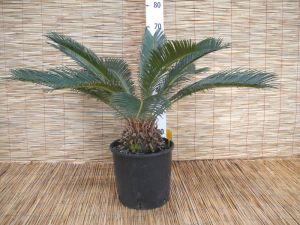-
x
Description
Cycas revoluta, height 90-110 cm.
Family: Cycadaceae.
Plant with an erect stem, very interesting from a decorative point of view, in fact, it has the appearance of a palm tree. The leaves are pinnate, evergreen, about 1.5 m long, a little arched and formed by many leathery leaflets of bright intense green color, linear and pointed at the tip. In both cases, the inflorescences are gathered in the center of the tuft of leaves. The seeds are fleshy and reddish in color, they can be eaten as food.
The flowers are formed at the center of the clump of leaves.
Area of Origin: Japan, Madagascar, and Oceania. Exposure and brightness if you live outdoors, can be exposed to direct sun or partial shade. Indoors ensure optimum brightness, avoiding direct exposure to sunlight, if filtered by glass.
Temperature: although a plant of tropical origin, it bears also quite low temperatures. Do not grow outdoors where the climate is too rigid. Can tolerate ranging from -10 ° C to 40 ° C in this way we can say that has no problem adapting. In milder climates is grown in the ground in the garden, in the coldest places, it should be cultivated in pots and can also be held flat. As a houseplant is much appreciated for its elegant demeanor. You usually need to repot the plant every 2 or 3 years.
Water: the water even in the hottest periods should be quite low. Allow the soil to dry out between waterings. This slow-growing plant has an excellent environmental resistance.
Fertilization: from March to September, adding fertilizer to the watering once a month, also very welcome mature manure. Pruning: In the spring you should remove older branches and dry parts, or damaged.
Diseases: may be subject to fungal foliar diseases and root rot if you create stagnant water, these problems can be avoided by following the proper care and choosing appropriate substrates.
Take care: Pay particular attention to watering in order to avoid the excess water and exposure, avoiding direct sunlight. Clean the leaves with a damp cloth if necessary and with monthly spraying. Do not use polishes leaf.


